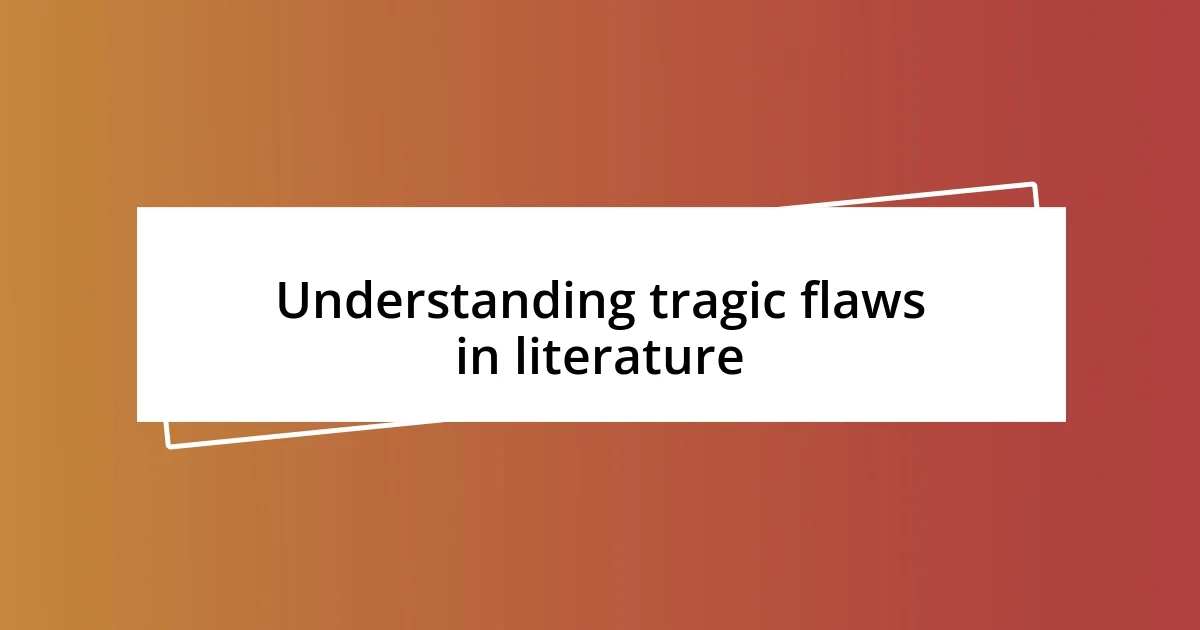Key takeaways:
- Tragic flaws, or “hamartia,” are inherent character defects that lead to their downfall, evoking empathy and reflection in readers.
- Analyzing tragic flaws reveals personal struggles and fosters a connection between readers and characters, emphasizing the impact of these flaws on narrative and personal growth.
- In both classic and modern literature, tragic flaws illustrate timeless human vulnerabilities, allowing writers to create relatable characters that resonate with readers’ own life experiences.

Understanding tragic flaws in literature
Tragic flaws, often referred to as “hamartia,” are those inherent defects or shortcomings in a character that lead to their ultimate downfall. I recall reading “Macbeth” in high school, where Macbeth’s ambition becomes his tragic flaw. Isn’t it fascinating how a seemingly positive trait can spiral into destruction?
These flaws can evoke deep empathy in readers. For example, I found myself reflecting on Jay Gatsby’s obsession with Daisy in “The Great Gatsby.” His relentless pursuit of an ideal often made me wonder—are we sometimes blinded by our desires? It’s this mix of admiration and pity that really drives home the tragic nature of flaws in literature.
Understanding these characters’ tragic flaws not only deepens our engagement with their stories but also allows us to reflect on our own lives. I often think about how our personal weaknesses can similarly shape our fates. Isn’t it poignant to realize that literature mirrors our reality, making us ponder the decisions we make every day?

Analyzing impact of tragic flaws
Tragic flaws don’t just endanger characters; they serve as a powerful narrative device that drives the entire plot. Reflecting on my readings, I remember how Oedipus’s search for the truth ultimately leads to his undoing. This makes me wonder—can the pursuit of knowledge sometimes come at a terrible cost? It’s a stark reminder that our gifts can also become our greatest curses.
When we analyze tragic flaws, we discover how they can resonate deeply with our own struggles. I often find myself thinking about Hamlet’s indecision—how familiar it is to feel paralyzed by choices. This connection fosters a unique bond between the reader and the character. I believe it’s essential for us to confront our own “hamartia,” as acknowledging these vulnerabilities can lead to personal growth.
Furthermore, the impact of tragic flaws extends beyond the characters; it influences the reader’s journey through the narrative. For instance, witnessing the downfall of a once-great hero often evokes a sense of loss. I recall closing “Death of a Salesman” feeling a profound sadness for Willy Loman, whose dreams were crushed by his own unrealistic expectations. This emotional experience lingers, pushing us to reflect on our definitions of success and the fragility of human ambition.
| Tragic Flaw | Impact on Character |
|---|---|
| Ambition | Macbeth’s thirst for power leads to destruction |
| Obsession | Gatsby’s fixation blinds him to reality |
| Indecision | Hamlet’s hesitation brings about tragedy |

Tragic flaws in modern literature
In modern literature, tragic flaws continue to resonate, resulting in characters who reflect our own struggles and vulnerabilities. I remember finishing “A Streetcar Named Desire” and feeling a swell of sympathy for Blanche DuBois. Her tragic flaw—her inability to confront reality—made me think about how often we avoid facing the truth in our lives. It’s intriguing how these characters’ painful journeys remind us that denial can lead to our own downfalls.
Here are some examples of tragic flaws found in contemporary works:
- Delusion: In “The Road,” the father’s unwavering hope for a brighter tomorrow drives him to make dire choices.
- Narcissism: Patrick Bateman in “American Psycho” embodies a self-centered existence that leads to violence and isolation.
- Fear of vulnerability: In “Little Fires Everywhere,” Mia’s reluctance to open up destroys her connection with those she loves.
The nuanced portrayal of tragic flaws in modern literature illustrates the timeless relevance of human imperfections. I can’t help but relate to the struggles these characters face. It’s a mirror, reflecting my own fears and considerations about how my flaws shape my decisions and relationships every day.

How tragic flaws shape narratives
Tragic flaws intricately weave through narratives, driving characters towards their inevitable fates. I often think about how these flaws can mirror societal values and our personal experiences. Take, for example, Jay Gatsby’s obsession with an idealized love; it not only leads to his downfall but also serves as a poignant commentary on the American Dream. Doesn’t it make you ponder how our own aspirations can sometimes blind us to reality?
When a character’s tragic flaw is revealed, it invites readers to delve deeper into the narrative’s emotional core. I recall reading “Othello” and feeling a mix of frustration and empathy as Iago’s manipulation exploits Othello’s insecurities. It highlights how vulnerabilities can be weaponized, transforming a noble character into a tragic figure. This makes me wonder—are we ever truly free from the grip of our flaws, or do they shape our destinies in ways we might not even see coming?
The unfolding of tragic flaws often serves as a catalyst for profound moments of introspection within readers themselves. I remember feeling an unsettling reflection of my own ambition while navigating through “Macbeth.” It left me questioning my own desires—how far would I go to achieve my goals? This connection turns each narrative into a mirror, prompting me to consider if my ambitions might lead me down a similar path of destruction. What lessons do we learn about ourselves from these flawed characters? Sometimes, the answer lies in their tragic choices.

Writing your own tragic flaw
Creating your own tragic flaw in writing can be a powerful tool for character development. I often think back to when I crafted a protagonist whose impulsiveness led them into one regrettable situation after another. It made me realize how easily we humans can bypass reason in the heat of the moment, just as in real life. Have you ever acted without considering the consequences? I know I have, and it genuinely helped deepen my character’s emotional journey.
As I continued writing, I found that my character’s tragic flaw opened up rich narrative possibilities. By exposing their vulnerabilities, I was able to invite readers into a world of complexity and conflict. It reminded me of my own tendency to procrastinate—how often do we delay important actions only to face dire consequences later? This introspection not only honed my writing but made it easier to connect with my audience, allowing them to see a part of themselves in my character’s struggle.
In my experience, choosing a flaw that resonates on a personal level can transform your story. For example, I once depicted a character wrestling with their fear of commitment. Reflecting on my past relationships, I found parallels and was able to infuse genuine emotion into their journey. Do we not all grapple with our own commitments and fears? By sharing such relatable flaws, I’ve learned that readers are more likely to become emotionally invested, rooting for growth and change in characters who mirror their own lives.














